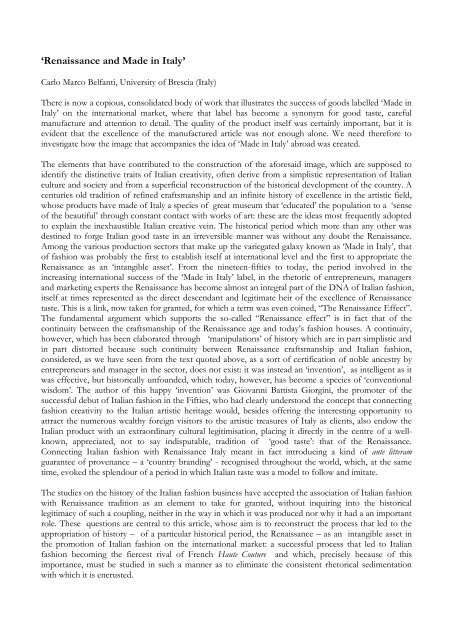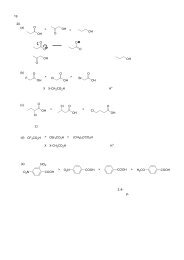'Renaissance and Made in Italy'
'Renaissance and Made in Italy'
'Renaissance and Made in Italy'
Create successful ePaper yourself
Turn your PDF publications into a flip-book with our unique Google optimized e-Paper software.
‘Renaissance <strong>and</strong> <strong>Made</strong> <strong>in</strong> Italy’<br />
Carlo Marco Belfanti, University of Brescia (Italy)<br />
There is now a copious, consolidated body of work that illustrates the success of goods labelled „<strong>Made</strong> <strong>in</strong><br />
Italy‟ on the <strong>in</strong>ternational market, where that label has become a synonym for good taste, careful<br />
manufacture <strong>and</strong> attention to detail. The quality of the product itself was certa<strong>in</strong>ly important, but it is<br />
evident that the excellence of the manufactured article was not enough alone. We need therefore to<br />
<strong>in</strong>vestigate how the image that accompanies the idea of „<strong>Made</strong> <strong>in</strong> Italy‟ abroad was created.<br />
The elements that have contributed to the construction of the aforesaid image, which are supposed to<br />
identify the dist<strong>in</strong>ctive traits of Italian creativity, often derive from a simplistic representation of Italian<br />
culture <strong>and</strong> society <strong>and</strong> from a superficial reconstruction of the historical development of the country. A<br />
centuries old tradition of ref<strong>in</strong>ed craftsmanship <strong>and</strong> an <strong>in</strong>f<strong>in</strong>ite history of excellence <strong>in</strong> the artistic field,<br />
whose products have made of Italy a species of great museum that „educated‟ the population to a „sense<br />
of the beautiful‟ through constant contact with works of art: these are the ideas most frequently adopted<br />
to expla<strong>in</strong> the <strong>in</strong>exhaustible Italian creative ve<strong>in</strong>. The historical period which more than any other was<br />
dest<strong>in</strong>ed to forge Italian good taste <strong>in</strong> an irreversible manner was without any doubt the Renaissance.<br />
Among the various production sectors that make up the variegated galaxy known as „<strong>Made</strong> <strong>in</strong> Italy‟, that<br />
of fashion was probably the first to establish itself at <strong>in</strong>ternational level <strong>and</strong> the first to appropriate the<br />
Renaissance as an „<strong>in</strong>tangible asset‟. From the n<strong>in</strong>eteen-fifties to today, the period <strong>in</strong>volved <strong>in</strong> the<br />
<strong>in</strong>creas<strong>in</strong>g <strong>in</strong>ternational success of the „<strong>Made</strong> <strong>in</strong> Italy‟ label, <strong>in</strong> the rhetoric of entrepreneurs, managers<br />
<strong>and</strong> market<strong>in</strong>g experts the Renaissance has become almost an <strong>in</strong>tegral part of the DNA of Italian fashion,<br />
itself at times represented as the direct descendant <strong>and</strong> legitimate heir of the excellence of Renaissance<br />
taste. This is a l<strong>in</strong>k, now taken for granted, for which a term was even co<strong>in</strong>ed, “The Renaissance Effect”.<br />
The fundamental argument which supports the so-called “Renaissance effect” is <strong>in</strong> fact that of the<br />
cont<strong>in</strong>uity between the craftsmanship of the Renaissance age <strong>and</strong> today‟s fashion houses. A cont<strong>in</strong>uity,<br />
however, which has been elaborated through „manipulations‟ of history which are <strong>in</strong> part simplistic <strong>and</strong><br />
<strong>in</strong> part distorted because such cont<strong>in</strong>uity between Renaissance craftsmanship <strong>and</strong> Italian fashion,<br />
considered, as we have seen from the text quoted above, as a sort of certification of noble ancestry by<br />
entrepreneurs <strong>and</strong> manager <strong>in</strong> the sector, does not exist: it was <strong>in</strong>stead an „<strong>in</strong>vention‟, as <strong>in</strong>telligent as it<br />
was effective, but historically unfounded, which today, however, has become a species of „conventional<br />
wisdom‟. The author of this happy „<strong>in</strong>vention‟ was Giovanni Battista Giorg<strong>in</strong>i, the promoter of the<br />
successful debut of Italian fashion <strong>in</strong> the Fifties, who had clearly understood the concept that connect<strong>in</strong>g<br />
fashion creativity to the Italian artistic heritage would, besides offer<strong>in</strong>g the <strong>in</strong>terest<strong>in</strong>g opportunity to<br />
attract the numerous wealthy foreign visitors to the artistic treasures of Italy as clients, also endow the<br />
Italian product with an extraord<strong>in</strong>ary cultural legitimisation, plac<strong>in</strong>g it directly <strong>in</strong> the centre of a wellknown,<br />
appreciated, not to say <strong>in</strong>disputable, tradition of „good taste‟: that of the Renaissance.<br />
Connect<strong>in</strong>g Italian fashion with Renaissance Italy meant <strong>in</strong> fact <strong>in</strong>troduc<strong>in</strong>g a k<strong>in</strong>d of ante litteram<br />
guarantee of provenance – a „country br<strong>and</strong><strong>in</strong>g‟ - recognised throughout the world, which, at the same<br />
time, evoked the splendour of a period <strong>in</strong> which Italian taste was a model to follow <strong>and</strong> imitate.<br />
The studies on the history of the Italian fashion bus<strong>in</strong>ess have accepted the association of Italian fashion<br />
with Renaissance tradition as an element to take for granted, without <strong>in</strong>quir<strong>in</strong>g <strong>in</strong>to the historical<br />
legitimacy of such a coupl<strong>in</strong>g, neither <strong>in</strong> the way <strong>in</strong> which it was produced nor why it had a an important<br />
role. These questions are central to this article, whose aim is to reconstruct the process that led to the<br />
appropriation of history – of a particular historical period, the Renaissance – as an <strong>in</strong>tangible asset <strong>in</strong><br />
the promotion of Italian fashion on the <strong>in</strong>ternational market: a successful process that led to Italian<br />
fashion becom<strong>in</strong>g the fiercest rival of French Haute Couture <strong>and</strong> which, precisely because of this<br />
importance, must be studied <strong>in</strong> such a manner as to elim<strong>in</strong>ate the consistent rhetorical sedimentation<br />
with which it is encrusted.
Until 1950 Italian fashion did not exist: there were of course able tailors <strong>and</strong> creative designers, who,<br />
however, were known only as <strong>in</strong>dividuals <strong>and</strong> not as part of a wider movement which identified it <strong>in</strong> a<br />
specific Italian style. Despite the existence of advanced skills able to give birth to an Italian fashion, there<br />
was no cultural identity to act as neither a coagulat<strong>in</strong>g factor nor an <strong>in</strong>ternational legitimisation that<br />
would allow the new form to compete with the dom<strong>in</strong>ant Parisian Haute Couture. The recovery – the<br />
<strong>in</strong>vention - of the Renaissance as an <strong>in</strong>tangible asset was the fundamental <strong>in</strong>strument by which this<br />
double lack was filled <strong>and</strong> it therefore became a key factor <strong>in</strong> the <strong>in</strong>ternational success of Italian fashion.




